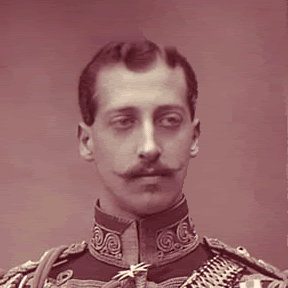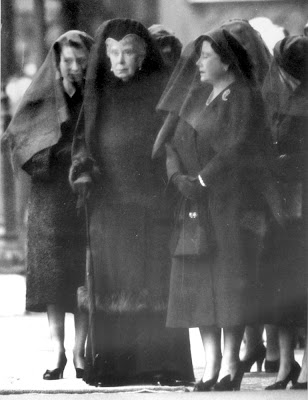
Elizabeth Alexandra Mary. Born April 21, 1926 at 17 Bruton Street, Mayfair, to Prince Albert, Duke of York (later King George VI) and Lady Elizabeth Bowes-Lyon, the Dutchess of York.
The family called her Lilibet.
Princess Elizabeth was born 3rd in line to the British throne, behind her Uncle The Prince Edward, Prince of Wales, and her father.
Elizabeth had one sibling, a sister, Margaret, four years her junior.

Elizabeth's uncle became Edward VIII in 1936, when she was 10 years old. Upon his abdication 11 months later, she became heiress presumptive to the throne. Her father reigned as George VI until early 1952.
Elizabeth's mother had harbored hopes her daughter might be educated in a public school, for the social experience as well as for the education. This was not to be as her uncle, the king, decided it would not do for her to be educated with commoners. She therefore was educated entirely in private. She studied Constitutional History under the vice-provost of Eton College. She has a love of history. She also studied modern languages. Elizabeth speaks fluent French.

Princess Elizabeth at age 16

The Princess met her future husband, Prince Philip of Greece and Denmark, for the first time in 1934 when she was 8 years old. Later, in 1939 when she was thirteen, she fell in love with him and they began to exchange letters.
During WWII, in 1944, when she was 18, she convinced her father to let her join the Auxiliary Territorial Service to help the war effort. Second Subaltern Elizabeth Windsor was trained as a truck driver and in heavy vehicle maintenance. She later attained the rank of Second Commander. She is still a good driver today. She is, incidentally, the last surviving head of state to have served in uniform in World War II.

On VE day (the end of the war in Europe) celebratory crowds filled the streets of London. The two princesses mingled anonymously with that throng.
"We asked my parents if we could go out and see for ourselves. I remember we were terrified of being recognized... I remember lines of unknown people linking arms and walking down Whitehall, all of us just swept along on a tide of happiness and relief."

The princess changes a truck wheel.
In November of 1947, Princess Elizabeth married Philip. They are second cousins once removed on his side of the family and third cousins through Queen Victoria. The country had not yet recovered from the war and, oddly, the princess still had to present rationing coupons for the material for her wedding gown. The marriage was not universally approved in the family: Prince Philip had no financial standing, and, though a British subject, was foreign-born.
Philip renounced his Greek and Danish titles and converted to Anglicanism. He assumed the name Lt. Philip Mountbatten (his mother's family name, Anglicized) but was created the Duke of Edinburgh before the marriage.

The couple's first child, Charles, was born in 1948, and their second, Anne, in 1950. The Royal Family House is Windsor. Their descendants have the surname Mountbatten-Windsor. They were to have two more children after Princess Elizabeth became queen.
In late 1951, Elizabeth and Philip toured Canada and visited U.S. President Harry S. Truman in Washington. The king's health was failing, and the princess carried with her a draft accession declaration just in case the king died while she was outside the UK. As it happened, in February of 1952, the couple found themselves in a remote area of Kenya when news arrived that her father had died. Philip gave her the news.
Her private secretary, Martin Charteris, discreetly asked her what name she intended to use as monarch. She replied, "Elizabeth, of course."
And so it was.


 Elizabeth Alexandra Mary. Born April 21, 1926 at 17 Bruton Street, Mayfair, to Prince Albert, Duke of York (later King George VI) and Lady Elizabeth Bowes-Lyon, the Dutchess of York.
Elizabeth Alexandra Mary. Born April 21, 1926 at 17 Bruton Street, Mayfair, to Prince Albert, Duke of York (later King George VI) and Lady Elizabeth Bowes-Lyon, the Dutchess of York. Elizabeth's uncle became Edward VIII in 1936, when she was 10 years old. Upon his abdication 11 months later, she became heiress presumptive to the throne. Her father reigned as George VI until early 1952.
Elizabeth's uncle became Edward VIII in 1936, when she was 10 years old. Upon his abdication 11 months later, she became heiress presumptive to the throne. Her father reigned as George VI until early 1952. The Princess met her future husband, Prince Philip of Greece and Denmark, for the first time in 1934 when she was 8 years old. Later, in 1939 when she was thirteen, she fell in love with him and they began to exchange letters.
The Princess met her future husband, Prince Philip of Greece and Denmark, for the first time in 1934 when she was 8 years old. Later, in 1939 when she was thirteen, she fell in love with him and they began to exchange letters.












